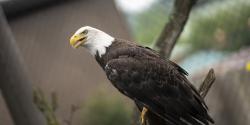As their name suggests, warthogs have pairs of fatty facial warts that help protect vital areas on their faces during sparring, especially for males.
Males tend to have larger warts and upper tusks, which are handy when fighting for mates.
Scientific Name: Phacochoerus africanus
Conservation Status: Least Concern
Size: Length from 3 to 5 ft. and shoulder height at about 2 to 3 ft.
Weight: 110 to 300 lbs.
Median Life Expectancy: Males 11.3 years; Females 12.3 years












